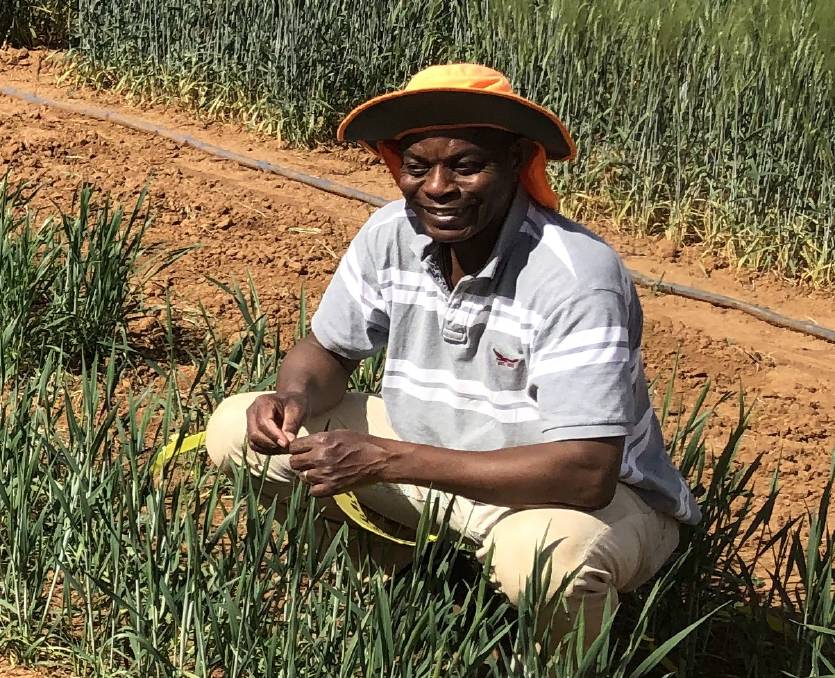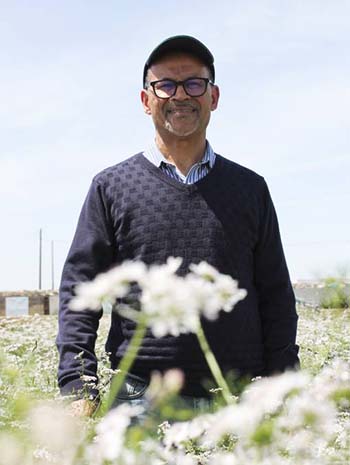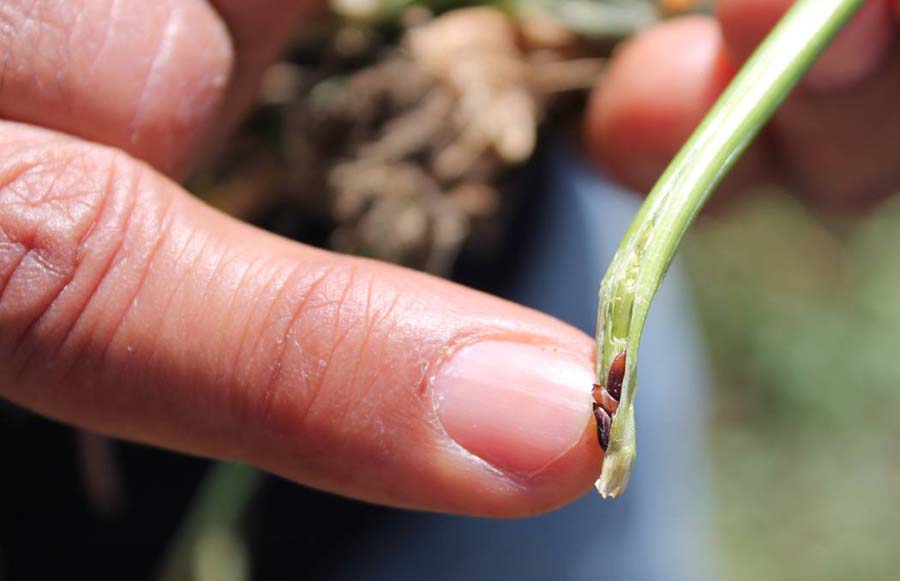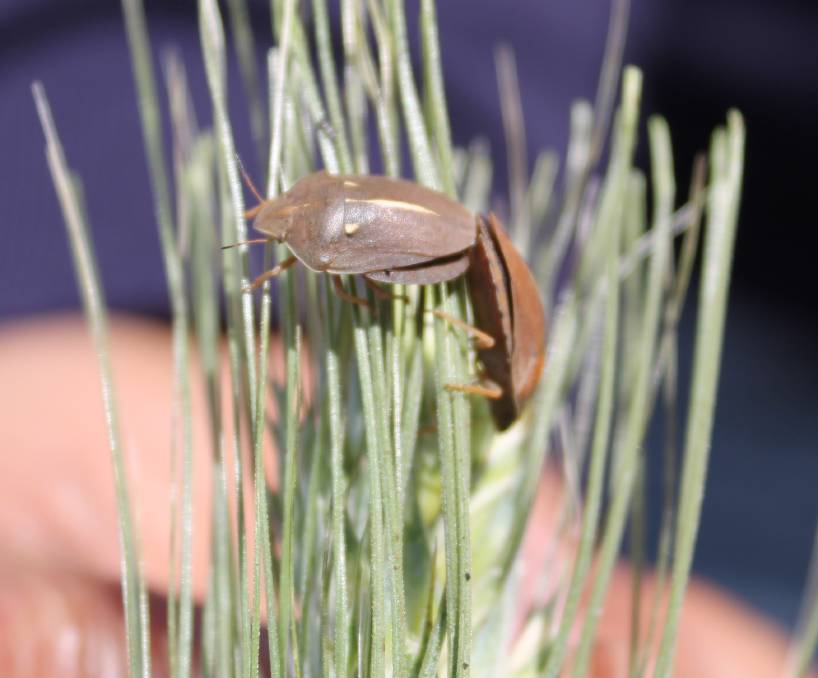Offshore wheat pre-breeding is providing new lines of genetic defence to help protect Australian grain growers from three of the world's most damaging crop insect pests and fungal pathogens.
A trifecta of biosecurity risk - international travel, trade globalisation and climate change - has stacked the odds in favour of new crop pests and pathogens breaching this country's quarantine defences.
These pressures are seeing expansion in the distribution and geographic range of exotic pests and pathogens around the world, leading to an increase in their global economic toll, estimated at US$1.4 trillion a year.

Dr Livinus Emebiri leads pre-emptive research to help shield Australian grain growers from the threat of exotic pest and disease incursions. Photo: NSW DPI
Among the world's most damaging crop insect pests and fungal pathogens are hessian fly (Mayetiola destructor), sunn pest (Eurygaster integriceps), and karnal bunt (Tilletia indica).
Although none of these species are present in Australia, a 1998 estimate suggested a karnal bunt incursion alone could claim about $491 million per annum from the national wheat crop.
Helping to avoid this economic toll in susceptible wheat varieties, and pre-empt all three biosecurity risks is new genetic protection co-developed by researchers at New South Wales Department of Primary Industries (NSW DPI) and the International Center for Agricultural Research in the Dry Areas (ICARDA).
Dr Livinus Emebiri, NSW DPI cereal geneticist for southern cropping systems, leads the GRDC-invested research effort between Australian and international scientists, spanning four countries:
- Australia
- Lebanon
- Mexico
- Morocco.
Dr Emebiri says the project has incorporated new resistance genes for sunn pest, hessian fly and karnal bunt into elite Australian germplasm for the development of new wheat varieties by this county's pre-breeders and breeders.
To this end, the partnership has also identified molecular markers, linked to insect and disease resistance, for use as a 'selection tool' to facilitate the rapid transfer of resistance genes contained in ICARDA germplasm to Australian cultivars.
The molecular markers will allow pre-breeders and breeders to track the resistance genes through plant breeding programs.
Overseeing ICARDA's biodiversity and integrated gene management program, senior wheat breeder, Dr Wuletaw Tadesse, says the resistant genes were added to the genetic profile of commercial cultivars nominated by the Australian grains research community.
These cultivars are Scout, Suntop and Mace.
"The research team at ICARDA has developed (doubled haploid) wheat lines carrying both single and combined resistance to hessian fly, sunn pest and karnal bunt in Australian wheat variety backgrounds," Dr Tadesse says.
Under pressure
 Dr Mustapha El Bousshini pointed out the damage to wheat plants caused by hessian fly and sunn pest at ICARDA's Marchouch research station in Morocco, North Africa. Photo: Clarisa Collis
Dr Mustapha El Bousshini pointed out the damage to wheat plants caused by hessian fly and sunn pest at ICARDA's Marchouch research station in Morocco, North Africa. Photo: Clarisa Collis
When GroundCover visited ICARDA's Marchouch research station near Rabat, Morocco, this year, ICARDA senior entomologist Dr Mustapha El Bousshini broke open the stem of a wheat plant to reveal the havoc caused by tiny hessian fly larva buried inside.
He also pointed out the damage caused by sap-sucking sunn pests feeding on wheat.
Standing knee-deep in experimental plots of wheat developed to resist these insect pests, Dr El Bousshini says the initial phase of the research highlighted the Australian wheat crop's vulnerability to the targeted pests and disease.
The findings of this early work effectively demonstrated the importance of the GRDC-invested research in securing new sources of genetic resistance to help protect vulnerable wheat varieties.
For example, a study of Australian wheat varieties at ICARDA's research station in Settat, Morocco, showed all 209 plant lines were 'completely susceptible' to hessian fly infestation.
Of 204 Australian wheat cultivars evaluated for sunn pest resistance in ICARDA trials at Terbol, Lebanon, 19 were rated resistant to moderately resistant.
Trials at the International Maize and Wheat Improvement Center (CIMMYT) in Obregon, Mexico, showed four of 200 Australian wheat lines, including durum and triticale, were consistently resistant to karnal bunt infection over three consecutive seasons.

Hessian fly larva buried inside the stem of a wheat plant. Photo: Clarisa Collis
Australian trials
Dr Emebiri says yield trials putting the new resistant germplasm to the test under Australian growing conditions showed it was competitive with this country's benchmark wheat varieties.
"We found no significant difference in grain yield between the new wheat lines carrying resistance genes and adapted commercial varieties in trials at Wagga Wagga, NSW, over two consecutive seasons," Dr Emebiri says.

Sap-sucking sunn pests traverse a head of wheat. Photo: Clarisa Collis
In other words, there was no yield penalty where the pest and disease-resistant germplasm was added to the genetic make-up of Scout, Suntop and Mace.
Seed packets containing the resistant germplasm have been delivered to NSW DPI researchers for distribution to Australian pre-breeders and breeders via the CIMMYT Australia ICARDA Germplasm Evaluation (CAIGE) project.
*NOTE: Clarisa Collis travelled to Morocco, in North Africa, with assistance from the Crawford Fund, as the 2018 winner of the Crawford Fund Food Security Journalism Award.
More information: Livinus Emebiri, livinus.emebiri@dpi.nsw.gov.au; Wuletaw Tadesse, w.tadesse@cgiar.org; Mustapha El Bouhssini, m.bohssini@cgiar.org

























































